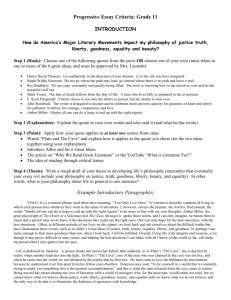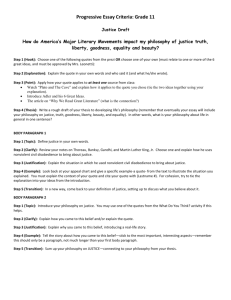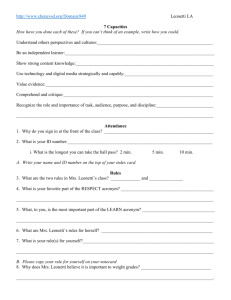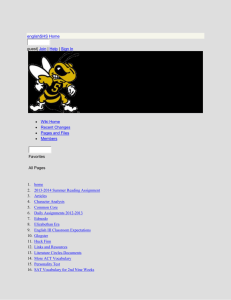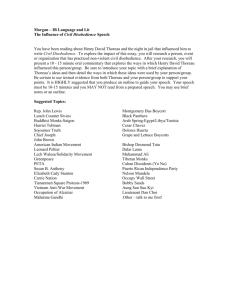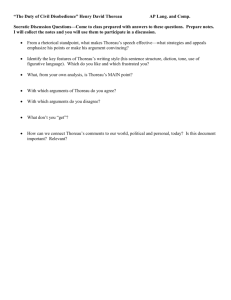Example Essay
advertisement
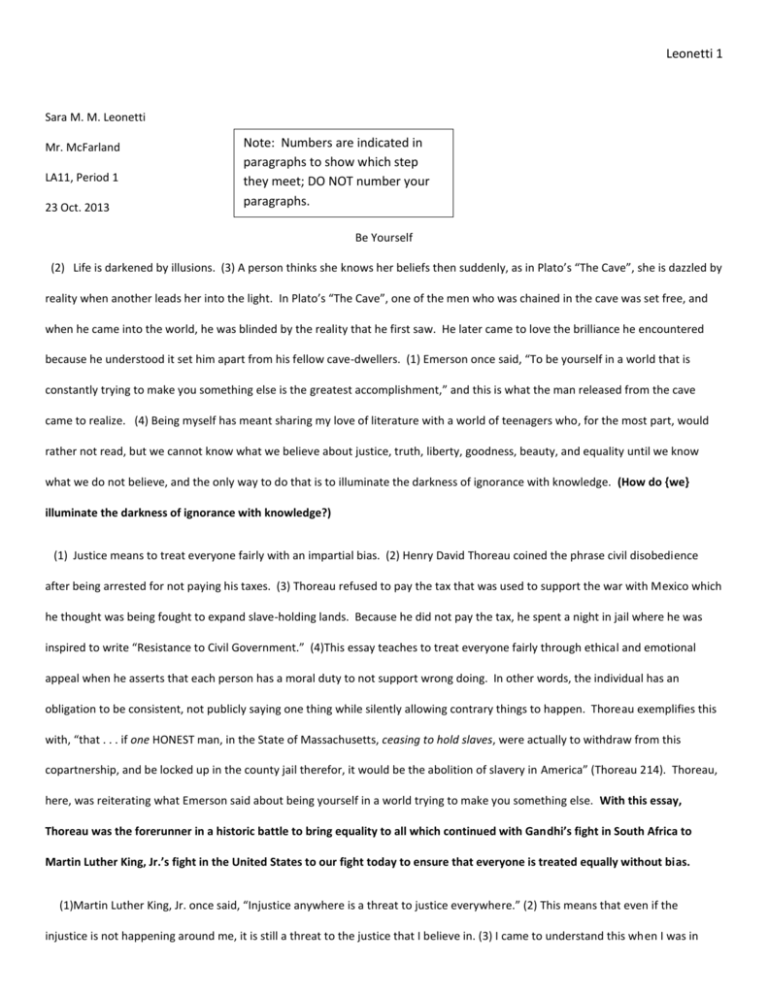
Leonetti 1
Sara M. M. Leonetti
Mr. McFarland
LA11, Period 1
23 Oct. 2013
Note: Numbers are indicated in
paragraphs to show which step
they meet; DO NOT number your
paragraphs.
Be Yourself
(2) Life is darkened by illusions. (3) A person thinks she knows her beliefs then suddenly, as in Plato’s “The Cave”, she is dazzled by
reality when another leads her into the light. In Plato’s “The Cave”, one of the men who was chained in the cave was set free, and
when he came into the world, he was blinded by the reality that he first saw. He later came to love the brilliance he encountered
because he understood it set him apart from his fellow cave-dwellers. (1) Emerson once said, “To be yourself in a world that is
constantly trying to make you something else is the greatest accomplishment,” and this is what the man released from the cave
came to realize. (4) Being myself has meant sharing my love of literature with a world of teenagers who, for the most part, would
rather not read, but we cannot know what we believe about justice, truth, liberty, goodness, beauty, and equality until we know
what we do not believe, and the only way to do that is to illuminate the darkness of ignorance with knowledge. (How do {we}
illuminate the darkness of ignorance with knowledge?)
(1) Justice means to treat everyone fairly with an impartial bias. (2) Henry David Thoreau coined the phrase civil disobedience
after being arrested for not paying his taxes. (3) Thoreau refused to pay the tax that was used to support the war with Mexico which
he thought was being fought to expand slave-holding lands. Because he did not pay the tax, he spent a night in jail where he was
inspired to write “Resistance to Civil Government.” (4)This essay teaches to treat everyone fairly through ethical and emotional
appeal when he asserts that each person has a moral duty to not support wrong doing. In other words, the individual has an
obligation to be consistent, not publicly saying one thing while silently allowing contrary things to happen. Thoreau exemplifies this
with, “that . . . if one HONEST man, in the State of Massachusetts, ceasing to hold slaves, were actually to withdraw from this
copartnership, and be locked up in the county jail therefor, it would be the abolition of slavery in America” (Thoreau 214). Thoreau,
here, was reiterating what Emerson said about being yourself in a world trying to make you something else. With this essay,
Thoreau was the forerunner in a historic battle to bring equality to all which continued with Gandhi’s fight in South Africa to
Martin Luther King, Jr.’s fight in the United States to our fight today to ensure that everyone is treated equally without bias.
(1)Martin Luther King, Jr. once said, “Injustice anywhere is a threat to justice everywhere.” (2) This means that even if the
injustice is not happening around me, it is still a threat to the justice that I believe in. (3) I came to understand this when I was in
Leonetti 2
Senior English Honors. In this class, we were assigned the book Cry, the Beloved Country. (4) This book is about apartheid in South
Africa. When I began reading the book, I knew next to nothing about the atrocities of the world, and I was shocked to discover that
this type of segregation could occur in a time much closer to my lifetime. It was then that I began to read about current world
events and discovered that issues like racism, segregation, and hate-crimes, which I believed to be a thing of the past, were, in fact,
still a very real part of the world. At first, I felt overwhelmed by this realization, and I thought there was nothing that I could do to
make a difference. But, after much research and reading, I realized that if I did not try to make a difference then who would? I
began to tell everyone I knew to read that book, and since I have become a teacher, I have continued to share these issues with my
students who, in their own small way, try to make their own difference in the world. (5) After all, as Gandhi pointed out, we must
be the change we wish to see in the world, and I have taken his words as my philosophy on justice.
(1) Truth is based in reality which is not always what is accepted as true. (2) A dystopia is an imagined future under a harsh
control that shines a light on the real world. (3)“Harrison Bergeron” by Kurt Vonnegut, Jr. is set in 2081, and “everyone is finally
equal.” (4) Dystopias make a criticism about a current trend; the criticism of a current trend in this story is the idea of making
everyone equal. In our society, many students have the expectation that they should get an “A” just for trying. This appears in the
story when Hazel says of the announcer who could not announce, “’That’s all right . . . he tried. That’s the big thing. He tried to do
the best he could . . . He should get a nice raise for trying so hard” (Vonnegut 2). He should get credit for trying, but a raise for being
average and not going above and beyond is out of the question. (5)The reality here is: everyone should be encouraged to excel in
their areas of expertise but also learn from mistakes to become well-rounded individuals who ultimately uncover the truth of
who they are and the world around them.
(1) Elie Wiesel, author of Night, asked the question, “Which is better, truth that is a lie, or lie that is truth?” (2) As a young man,
Wiesel, a young man of 15, was sent to a concentration camp along with his family for the lies, or propaganda that Hitler spread
through Germany and its bordering countries; the people of these countries came to accept Hitler’s lies as truth. (3) I read this book
for the first time to teach it to my first class of seniors at Eagle High School. Of course, I had learned about the holocaust, but this
real-life story had a profound impact on me because of the horridness of the truth it told. (4) I used this book to teach my students
about the lies that the world has been told about its people and how, even though we would like to believe these issues are of the
past, they are not—genocides have occurred since and still occur today because of the lies that others spread about the different
peoples and beliefs of the world. (5) The answer to Wiesel’s question is my philosophy on truth—neither—the only truth is the
one based in reality: we are all of the human race and all deserve to live lives of peace and freedom despite our race or religion.
Leonetti 3
(1) Liberty is freedom from restrictions imposed by an outside force. (2) Abraham Lincoln, president of the United States during
the Civil War, is iconic of this freedom for his work on The Emancipation Proclamation. (3) The Emancipation Proclamation issued on
January 1, 1863, in the third year of the war, only freed the slaves in the states that had seceded from the union. (4) However, the
theme of freedom for all was not lost in that “The Proclamation announced the acceptance of black men into the Union Army and
Navy, enabling the liberated to become the liberators” (U.S. National Archives). (5) In this way, the very men who were enslaved
were able to be a part of removing the chains that were the darkness of so many people’s lives for so long.
(1) Alex Haley, author of Roots, wrote in his book, “Through this flesh, which is us, we are you, and you are us!” (2) His book,
subtitled “The Saga of an American Family” tells the history of a family who are the descendants of slaves, taking the story all the
way back to a young boy stolen from his family in Africa; it was through reading this book that I learned how deep the pain of slavery
actually runs. (3-4) This book was on my family’s bookshelf for years, a lengthy tome, looming there enticing me to read it; I picked
it up, finally, when I was in college, and I discovered how even though we believe the issue of slavery to be over, it is not. As long as
people are stolen from their homes and forced to do anything against their will, we have not achieved true liberty. I came to
understand this further when I read “21st Century Slaves” in National Geographic several years ago, uncovering that the issue of
slavery believed to have been abolished is still rampant throughout the world and even in the United States. (5)Therefore, I have
made it my philosophy to bring light to the atrocity of slavery that still exists to those who may still be living in the dark about this
terrifying issue.
(1) Goodness means doing what is morally right despite the situation in which one finds oneself. (2) Mark Twain, author of
Huckleberry Finn, used regionalism in his realism to depict the gritty details of slave-life. (3) However, through these details, Twain
effectively illustrates how a 10-year-old boy, Huck, comes to understand that what is good is not necessarily what he has been
taught by the adults in his life. (4)Through the theme of intellectual and moral education, Huck is taught by the Widow Douglass,
Miss Watson, and even his drunken Pap that slaves are lesser than the white people who own them, but Huck’s real education
comes on the raft as he learns about who Jim really is; it is clear that Huck’s views differ from those of the adults in his life when he
says to Jim, “They’re after us” (Twain 62) as he runs back having learned that people are coming to look for him on Jackson’s Island.
(5) Through the fog of what he has been taught, the light of goodness shines through illuminating for Huck that Jim is just as
human as himself.
(1) Louisa May Alcott, author of Little Women, wrote in her book, “Some people seemed to get all sunshine, and some all
shadow…” (2) This book tells the story of sisters who lived in Concord, Massachusetts with parents who lived by Thoreau’s
Leonetti 4
philosophy of transcendentalism; this was one of the stories that I believe ignited my interest in reading and writing, but also helped
me develop my sense of goodness. (3-4) One of the sisters, Beth, is pure goodness; she is always sweet and kind, but her sister, Jo,
struggles with doing what is right according to her parents’ philosophy all of the time. Jo helped me understand that there is both
dark and light inside of each us, but it is through making the right choice in each situation that determines whether or not a person is
good. (5) To be good, a person must be willing to be the only one holding the lit candle even when it is in danger of being blown
out by the winds of evil that are always blowing.
(1) Equality is treating everyone the same regardless of differences. (2) Although the 14 th amendment heralded voting rights for
all men born in the United States in 1868, it was not until 1920 that women earned the right to vote, (3) but there was one woman
who encompassed both rights for slaves and rights for women in 1851, Sojourner Truth. In her speech, “And Ain’t I a Woman?”
given at a women’s right convention in Akron, Ohio, (4) Truth pointed out, “That man over there say that women needs to be helped
into carriages, and lifted over ditches, and to have the best place everywhere. Nobody ever helps me into carriages, or over mudpuddles, or give me any best place! And ain’t I a woman” (Truth 716)? (5) With this phrase she refutes all of the arguments that
women were frail and fragile thereby showing that every woman should be treated equally regardless of differences, and that it
is often man’s own ignorance that hides the light of equality.
(1) “If you want to see the true measure of a man, watch how he treats his inferiors, not his equals,” said J.K. Rowling, author of
the infamous Harry Potter series. (2) When students were asked who was their favorite female author, Rowling was the
overwhelming response, but I wonder, was it because she is really their favorite, or the only female author they could think of. I am
afraid it is the latter. (3) These same students have been required to read To Kill a Mockingbird, but the name of the woman who
slapped equality in the face with a little girl named Scout, escapes them. (4) This character by Harper Lee has similar attributes to
the popular Hermione. Both are headstrong girls who fight for the rights of the underdog, and find their own wisdom despite what
society tells them to believe about equality. (5) This ignorance about female authors and female characters remains a dreary
reminder of how little students are taught about phenomenal girls and women who have brightened the world through their
unique interpretation of the society that surrounds them.
(1)Beauty is a brilliance that illuminates the darkness of our soul, bringing joy to those who encounter it, (2) but society makes
beauty all about the superficial, only the surface. (3) “Barbie Doll” by Marge Piercy is a poem about a young girl who loses sight of
what is on the inside because of what others point out about the outside. (4) She was raised like all other little girls, but then, “In
the magic of puberty, a classmate said: You have a great big nose and fat legs.” It is then that she learns to question her intelligence
Leonetti 5
and worth as a whole person and is finally driven to cut off her nose and legs, committing suicide. (5) It is the irony of the last
stanza, when she has consummation for being beautiful only after the mortician has made her so that makes the reader realize
that society can really diminish the light that shines within.
(1) As Albert Camus explained, “Beauty is unbearable, drives us to despair, offering us for a minute the glimpse of eternity that we
should like to stretch out over the whole of time.” (2) One of my favorite classic books is The Great Gatsby; I have loved it since the
first time I had to read it in high school. (3) Of course then, I did not understand that depth of the characters or their obsession with
what each of them found beautiful, but as I have read it over and over I see more and more the despair that their yearning for
beauty drives them to. (4) They are all searching for a way to remain or hold on to what is young and beautiful, and it is through this
twisted tale of the death of the American dream that I discovered that beauty is the light that we are all drawn to. (5)It is coming to
understand that beauty is a glow from within that only shines through when we have written our own philosophies by reading
from literature that makes up the library of the world.
(1) To uncover the real justice, truth, liberty, goodness, equality, and beauty one must flip through the pages to bring to light the
facts hidden between the lines. (2) Justice is uncovered in Thoreau’s “Resistance to Civil Government”, and I discovered that I must
live the change I want to see in the world. Truth is illuminated with dystopian stories like Vonnegutt’s “Harrison Bergeron”, and I
found that the only truth that matters is that we are all a part of the human race like Abraham Lincoln showed in “The Emancipation
Proclamation” to bring about liberty. While doing what is good may seem obvious, Mark Twain showed in Huckleberry Finn that we
must be critical of the mores of the society in which we live just like Sojourner Truth did in “And Ain’t I a Woman” when she fought
in the battle to bring equality to everyone regardless of race or sex. Even though historically and literarily these lessons have been
learned, beauty as shown by F. Scott Fitzgerald in The Great Gatsby can still hold us back unless we realize the superficial will only
extinguish the flame. Reading from a young age until today has made me who I am and helped me develop my philosophy. Even as
I re-read books I have read before, a spark is lit when I come across something I never noticed before. This is why I wanted to be a
teacher of literature, and this why even though not every student wants to read I have come to the philosophy that (3) However,
life is darkened by the illusions we create for ourselves or those that are created for us; in “The Matrix and The Cave” it is seen how
people can be chained to the system in more than one way—in “The Cave” this is literal, in “The Matrix” the people are the batteries
for the automatons that live in the actual world. (4) the only way, “To be yourself in a world that is constantly trying to make you
something else” is to unplug from the system, and hold your knowledge up high to be a flame that burns through the pitch black of
ignorance.
Leonetti 6
